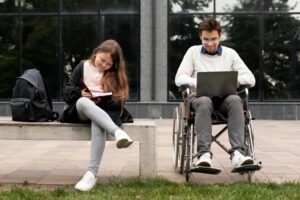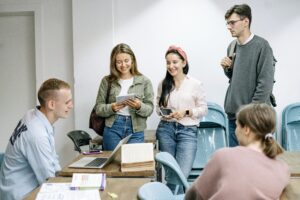Other CPD opportunities
Materials
1. Introduction
Continuous Professional Development (CPD) is essential in ensuring that educators, both teachers and leaders, stay informed about new advancements and methodologies in education. In the modern educational landscape, CPD helps educators enhance their skills in curriculum development, student engagement, and digital literacy. Moreover, with the rapid pace of technological change, there is an increasing demand for professional growth in areas related to digital tools and inclusive education. CPD fosters a culture of continuous improvement, allowing educators to meet evolving educational challenges (Ahmed et al., 2021).
As digital technologies become more prevalent in education, the importance of CPD focused on inclusive digital education grows. Educators must acquire the skills necessary to make digital environments accessible to all students, regardless of their physical, cognitive, or socio-economic circumstances. Inclusive digital education aims to remove barriers to learning and ensure all students can participate fully in digital learning spaces (Cast, 2024).
2. Online Professional Learning Communities (PLCs)
Online Professional Learning Communities (PLCs) allow educators to collaborate and share experiences, fostering a peer-to-peer learning culture. PLCs enable teachers and managers to explore best practices in inclusive digital education, often through forums, webinars, and collaborative projects. These communities are dynamic spaces where educators can discuss challenges, strategies, and the use of new digital tools in promoting inclusion (Gaible & Burns, 2005).
For inclusive digital education, PLCs offer valuable opportunities to explore how specific technologies can support students with special needs. For example, members can share insights using assistive technologies such as text-to-speech software or tools that adjust digital content to different learning styles. By exchanging ideas and resources in PLCs, educators can stay informed about the latest developments and practical strategies for enhancing digital inclusivity (Wenger, McDermott, & Snyder, 2002).
A successful example of an Online Professional Learning Community (PLC) can be found in the eTwinning platform, a European Commission initiative that connects schools across Europe. Through eTwinning, educators collaborate on joint projects, share teaching resources, and engage in professional exchanges across borders. One case study from Finland showcased how teachers used the platform to implement a cross-curricular project integrating history, technology, and critical thinking, which involved collaboration with students from different countries. The platform also enabled educators to share strategies for incorporating digital tools into their teaching practices (European Schoolnet, 2023).
In the context of inclusive digital education, this example could be adapted by creating specialized PLCs that share best practices and strategies for making digital content accessible to all learners. Educators could collaborate on designing digital lesson plans incorporating assistive technologies, share experiences using adaptive learning tools, and discuss methods for creating an inclusive classroom environment, regardless of students’ abilities or geographic locations.
3. Micro-Credentials and Digital Badges
Micro-credentials and digital badges provide educators with the opportunity to develop specific skills through short, focused courses. These credentials are valuable in helping educators build expertise in targeted areas like digital accessibility or Universal Design for Learning (UDL). Platforms such as Coursera or EdX offer certifications in educational technologies that support inclusion, such as tools for creating accessible digital materials (Raouna, 2023).
By earning micro-credentials, educators demonstrate their proficiency in integrating digital tools that cater to diverse learners. This includes learning how to use adaptive technologies or developing accessible online content, ensuring that all students, including those with disabilities, can engage with the material. As a result, micro-credentials contribute significantly to developing inclusive digital education environments (He, 2022).
A notable case study on using micro-credentials can be seen in the BloomBoard platform, which partners with educational institutions to offer competency-based learning programs. In one instance, a district in North Carolina used BloomBoard to offer micro-credentials in areas such as personalized learning and student engagement. Educators earned badges after demonstrating proficiency in these areas, which could be applied toward district recognition and career advancement. The micro-credentialing system allowed educators to focus on specific skills relevant to their needs and provided flexibility regarding when and how they completed the required learning tasks (BloomBoard, 2022).
For inclusive digital education, similar micro-credential programs could focus on developing expertise in accessible technology, Universal Design for Learning (UDL), or adaptive tools for students with disabilities. Teachers could earn micro-credentials for mastering software that supports students with visual impairments or learning disabilities, thus ensuring that they are equipped to offer a more inclusive digital learning environment.
4. Blended Learning Workshops
Blended learning workshops combine online and in-person instruction, allowing educators to develop both technical skills and pedagogical strategies. These workshops often provide practical, hands-on training with digital tools, alongside discussions about inclusive teaching methods. Blended learning allows educators to experiment with digital platforms while receiving real-time feedback, making it a highly effective CPD method (Billett, 2012).
For inclusive digital education, blended learning workshops enable educators to learn how to implement adaptive learning technologies, ensuring students with various learning needs are supported. These workshops help educators understand how to balance traditional teaching methods with digital tools to create an inclusive, flexible learning environment (Bower, 2017).
A compelling example of a successful blended learning workshop is the Khan Academy Teacher Training Program, which provides educators with in-person workshops and online modules to help integrate Khan Academy’s resources into their teaching. Educators in various regions have participated in blended workshops where they learned not only how to use Khan Academy’s vast repository of digital content but also how to balance it with in-person classroom instruction. This hybrid approach allowed teachers to explore technology tools while receiving immediate feedback and support from peers and facilitators (Khan Academy, 2021).
In terms of inclusive digital education, this blended workshop model could be adapted to focus on helping educators integrate digital accessibility tools into their classrooms. Workshops could include online sessions that demonstrate screen readers or closed captioning in digital materials, followed by in-person discussions on how to apply these tools in various educational settings. The blended format ensures that educators receive both technical training and practical, classroom-based advice.
5. Massive Open Online Courses (MOOCs) for Inclusive Digital Education
Massive Open Online Courses (MOOCs) provide accessible, flexible learning options for educators seeking to enhance their digital and inclusive teaching skills. MOOCs, offered by platforms like FutureLearn and Canvas Network, allow educators to delve into topics such as digital inclusion, assistive technology, and inclusive pedagogy (Ahmed et al., 2021).
For teachers and managers focused on inclusive digital education, MOOCs are valuable because they provide global perspectives on inclusion and digital learning strategies. These courses often include case studies, real-world examples, and practical advice on using digital tools to make learning more accessible to students with disabilities (European Schoolnet, 2023). By participating in MOOCs, educators gain insights into best practices for digital inclusion and develop actionable strategies for improving their teaching environments.
An example of the successful implementation of MOOCs is Harvard University’s Professional Development Program through edX, which offers a series of courses aimed at enhancing teaching and learning in digital spaces. One course, “Leaders of Learning,” explored different learning environments and their impacts on teaching. Educators worldwide took part in this course to understand how to create more effective learning ecosystems using digital tools (Harvard University, 2022).
This model could be applied to inclusive digital education by creating MOOCs focused on digital accessibility. For example, a course could cover how to implement the principles of Universal Design for Learning (UDL) and use adaptive technologies like voice recognition software. Such MOOCs would provide educators with comprehensive knowledge about inclusive practices, which they could apply directly in their classrooms to make digital content accessible to all learners.
6. Action Research in Digital Inclusion
Action research offers a reflective approach to CPD, enabling educators to investigate and improve their own practices. Through action research, educators can explore how specific digital tools or inclusive strategies affect student engagement and learning outcomes. This method fosters a continuous cycle of learning and improvement (Stringer, 2013).
In the context of inclusive digital education, action research allows teachers to test digital tools designed for accessibility and assess their effectiveness. For example, a teacher might investigate the impact of using screen readers or closed-captioning tools on student participation. By collecting data on these interventions, educators can refine their teaching approaches to better meet the needs of all learners (Sagor, 2000).
A great example of action research comes from a study conducted by the University of Southern Queensland, where educators implemented a flipped classroom model and then used action research to measure its effectiveness on student engagement and learning outcomes. The teachers gathered data on student participation, analyzed the results, and adapted their strategies to improve both the digital and in-person aspects of the classroom (Wilson et al., 2020).
In inclusive digital education, a similar approach could be used to test how digital tools impact students with specific learning challenges. For instance, educators could conduct action research to measure the effectiveness of text-to-speech software in improving the engagement of students with reading difficulties. The data collected would allow teachers to adapt their methods based on what works best, ensuring that their use of digital tools effectively supports inclusive practices.
7. Cross-Institutional Collaboration and Exchange Programs
Cross-institutional collaboration and exchange programs are essential for Continuous Professional Development (CPD) as they provide educators with unique opportunities to observe, learn, and share innovative teaching methods across different educational contexts. These collaborations can be shared research projects, co-teaching arrangements, virtual exchanges, or short-term placements in partner institutions. Such programs expose educators to diverse teaching practices, curricula, and technological tools, enabling them to bring fresh perspectives back to their home institutions (Wells et al., 2019). These exchanges not only broaden participants’ professional knowledge but also foster the development of global networks that facilitate continuous learning and innovation in education.
In the context of inclusive digital education, cross-institutional collaboration is invaluable. It allows educators to explore how other institutions integrate digital tools to support diverse learners, including those with disabilities, socio-economic challenges, or language barriers. Through these exchanges, educators can observe how schools and universities apply Universal Design for Learning (UDL) principles, utilize assistive technologies, and create inclusive digital environments (Wenger et al., 2002). Programs like Erasmus+ are instrumental in facilitating such collaborations, offering a structured framework for institutions across Europe (and beyond) to work together on joint educational projects that emphasize inclusivity and the use of digital resources.
The Erasmus+ program is one of the most significant examples of cross-institutional collaboration, fostering exchanges between universities, schools, and vocational education institutions across Europe. Launched by the European Union, Erasmus+ supports various activities, including staff mobility, strategic partnerships, and capacity-building projects. By enabling educators to work in different countries and collaborate with international peers, the program helps participants gain new pedagogical insights, develop intercultural competencies, and explore innovative teaching methods. For educators focused on inclusive digital education, Erasmus+ offers a platform to learn how other institutions use technology to create accessible learning environments and improve student engagement (European Commission, 2020).
One notable feature of Erasmus+ is its emphasis on professional development through mobility programs. Educators participating in Erasmus+ mobility exchanges often engage in job shadowing, teaching assignments, or structured training at partner institutions. These experiences are invaluable for gaining hands-on knowledge about digital education practices. For instance, educators can observe how institutions implement learning management systems (LMS) that support students with diverse needs, or how blended learning models foster inclusivity (European Commission, 2020). The lessons learned during these exchanges can then be adapted to the educators’ home institutions, contributing to developing more inclusive digital classrooms.
Examples of Successful Erasmus+ Projects:
- DigiEduHack: Supporting Digital Skills and Inclusion – The DigiEduHack initiative is part of an Erasmus+ project that brought together European teachers to develop innovative solutions for enhancing digital skills in inclusive education. Participants collaborated on strategies for using digital tools to support students with disabilities and language barriers. One successful outcome was the development of a virtual learning platform that featured multi-lingual support and accessibility tools like text-to-speech and visual aids. This project exemplified how cross-institutional collaboration can lead to the creation of adaptable digital resources that promote inclusivity in the classroom (European Commission, 2020).
- INCLUDE – Promoting Inclusive Education in Schools – The INCLUDE project, funded by Erasmus+, focused on improving inclusive teaching practices in schools by fostering collaboration among educators from Italy, Spain, and Norway. Through workshops, job shadowing, and joint lesson plans, the project aimed to create inclusive teaching methods that could be implemented across different educational systems. Teachers gained practical experience using digital tools to support students with special educational needs, such as designing digital materials with adjustable difficulty levels to accommodate diverse learning abilities. The project also emphasized using assistive technologies, such as voice recognition and touch-screen devices, to enhance digital accessibility (INCLUDE, 2021).
- eConfidence – Enhancing Teachers’ Confidence in Digital Tools – The eConfidence Erasmus+ project sought to boost teachers’ confidence in using digital tools for inclusive education. Educators from five European countries collaborated to develop a series of online training modules that provided practical guidance on incorporating digital technologies into lesson planning. The project also focused on strategies for addressing digital equity, ensuring that all students, regardless of socio-economic background, had access to the necessary tools and resources for learning. Teachers who participated in the project reported greater confidence in using technologies like learning apps, interactive whiteboards, and virtual classrooms to support student engagement and inclusion (European Commission, 2019).
- IMPACT – Improving Access to Inclusive Digital Education – The IMPACT project brought together educators from universities in Germany, Greece, and the Czech Republic to explore how inclusive digital education can be integrated into higher education curricula. The project focused on creating digital resources, such as e-learning modules, that addressed the specific needs of students with disabilities. By working together, educators from different institutions developed a set of guidelines for incorporating UDL principles into course design, ensuring that all students had equal opportunities to participate in digital learning environments. This project highlighted how collaborative efforts across institutions can lead to practical solutions for making higher education more inclusive (IMPACT Project, 2022).
- TeachUP – Teacher Upskilling Through Collaboration – The TeachUP project, supported by Erasmus+, aimed to improve the digital skills of teachers across Europe by fostering collaboration between educators and educational institutions in 10 countries. The project involved a combination of online courses, peer learning activities, and face-to-face workshops. Participants shared best practices for integrating technology into classroom instruction and developed joint resources that could be used to support students with diverse learning needs. One key outcome of the project was the creation of an online repository of teaching materials, including interactive activities and digital lesson plans that educators could use to enhance inclusivity in their classrooms (TeachUP, 2020).
Programs like Erasmus+ are crucial for CPD as they provide educators with the opportunity to engage in professional exchanges that go beyond the boundaries of their institutions. By working with peers from other countries, educators gain access to new teaching methodologies, pedagogical tools, and innovative approaches to inclusive digital education. These experiences are particularly important in the context of digital transformation, where the rapid integration of technology requires constant learning and adaptation (European Commission, 2020).
Moreover, these collaborations foster a sense of global citizenship among educators, helping them develop intercultural competencies essential in today’s diverse educational environments. The exchange of knowledge and best practices through Erasmus+ projects enables educators to improve their teaching practices, making learning more accessible and inclusive for all students, regardless of their backgrounds or abilities. By participating in these programs, educators contribute to developing a more inclusive and digitally connected global education system.
8. Mentoring and Coaching in Inclusive Digital Practices
In-house mentoring and coaching programs provide a structured form of professional development, where experienced educators guide their colleagues in using inclusive digital teaching strategies. Mentoring offers personalized, ongoing support, allowing less experienced teachers to develop confidence in using digital tools for inclusion. Coaching, often more structured, helps educators set specific goals related to digital inclusion and receive feedback as they progress (Jones & Smith, 2022).
Mentoring and coaching are particularly beneficial for inclusive digital education because they provide targeted support for educators unfamiliar with digital tools that promote accessibility. For instance, a coach might help teachers integrate assistive technologies into their lesson plans or demonstrate how to create inclusive online assessments (Reitman & Benatti, 2021). These relationships foster continuous growth, allowing educators to develop practical skills that benefit their students.
A successful example of mentoring and coaching is the National Center for Literacy Education (NCLE), which developed a coaching program to help educators improve literacy instruction through technology integration. Coaches worked one-on-one with teachers, offering tailored feedback on incorporating digital tools into their literacy teaching. This personalized support helped teachers feel more confident and competent in using digital resources effectively (NCLE, 2022).
For inclusive digital education, a similar coaching program could focus on helping teachers implement digital accessibility tools in their classrooms. Coaches with expertise in inclusive education could guide teachers through the process of integrating technologies like speech-to-text, alternative input devices, or screen readers, providing feedback and support to ensure that these tools are used effectively to support all learners.
9. Conclusion
The opportunities outlined in this paper provide a diverse range of CPD options that contribute to developing inclusive digital education. Whether through online learning communities, micro-credentials, blended learning, or action research, educators can deepen their understanding and enhance their skills in using digital tools to support all learners. By engaging in these CPD opportunities, teachers and managers ensure that their teaching practices remain innovative and inclusive, fostering a learning environment where every student can thrive.
10. References
Ahmed, S. K., Mitchell, P., & Trevitt, J. (2021). Rapid Review of Effective Practice Principles in the Design and Delivery of Digital Resources for Teachers.
Billett, S. (2012). Guided Learning. In N. M. Seel (Ed.), Encyclopedia of the Sciences of Learning (pp. 1403–1406). Springer US.
BloomBoard. (2022). Using Micro-Credentials to Support Educator Career Growth. https://bloomboard.com
Bower, M. (2017). Design of Technology-Enhanced Learning: Integrating Research and Practice. Emerald Group Publishing.
Cast. (2024). The UDL Guidelines. https://udlguidelines.cast.org/
European Commission. (2019). eConfidence: Boosting Teacher Confidence in Using Digital Tools. https://ec.europa.eu/programmes/erasmus-plus/project/econfidence
European Commission. (2020). Erasmus+ Programme: Learning Mobility of Individuals. https://ec.europa.eu/programmes/erasmus-plus/opportunities/individuals_en
European Schoolnet. (2023). Reflecting Forward: European Schoolnet’s Annual Report 2023. http://www.eun.org/news/detail?articleId=11657266
Gaible, E., & Burns, M. (2005). Using Technology to Train Teachers: Appropriate Uses of ICT for Teacher Professional Development in Developing Countries. infoDev / World Bank.
Harvard University. (2022). Leaders of Learning. https://online-learning.harvard.edu/course/leaders-learning
He, G. (2022). 13 Top Online Learning Platforms for Professional Development. https://teambuilding.com/blog/online-learning-platforms
INCLUDE. (2021). INCLUDE – Promoting Inclusive Education in Schools. https://include-erasmus.eu
IMPACT Project. (2022). Improving Access to Inclusive Digital Education. https://impact-project.eu
Jones, J., & Smith, H. A. (2022). A Comparative Study of Formal Coaching and Mentoring Programs in Higher Education. International Journal of Mentoring and Coaching in Education, 11(2), 213–231.
Khan Academy. (2021). Teacher Training Program. https://www.khanacademy.org/teacher-training
National Center for Literacy Education (NCLE). (2022). Coaching Teachers to Integrate Technology into Literacy Instruction. https://www.ncte.org/ncle
Raouna, K. (2023). 30 Best Online Learning Platforms for 2024. https://www.learnworlds.com/online-learning-platforms/#Online_Learning_Platforms_VS_Online_Course_Platforms
Reitman, A., & Benatti, S. (2021). Mentoring vs Coaching: The Key Differences and Benefits. https://www.td.org/insights/mentoring-versus-coaching-whats-the-difference
Sagor, R. (2000). Guiding School Improvement with Action Research. ASCD.
Stringer, E. (2013). Action Research (4th ed.). SAGE Publications.
TeachUP. (2020). Teacher Upskilling Through Collaboration. https://teachup.org
Wenger, E., McDermott, R., & Snyder, W. (2002). Cultivating Communities of Practice: A Guide to Managing Knowledge. Harvard Business Press.
Wells, M., Ramirez, R., Scott, L., & Hudson, S. (2019). Educational Change Through Collaboration: Promising Pathways and Partnerships. Sense Publishers.
Wilson, K., Friedrichsen, P., & Barnard, R. (2020). Using Action Research to Evaluate the Effectiveness of Flipped Classrooms. Journal of Educational Technology Development and Exchange, 13(1), 1-15.
4. Continuous Professional Development Addition
Continuous Professional Development for Inclusive Digital Teaching – Part 2
CDPXX7
10 min
Participants will be able to:
- identify CPD methods that support inclusive digital education,
- evaluate the benefits of various CPD opportunities for fostering inclusive practices,
- analyze how CPD can improve the use of digital tools for inclusive education.
online learning communities; micro-credentials; blended learning; action research; cross-institutional collaboration








Funded by the European Union. Views and opinions expressed are however those of the author(s) only and do not necessarily reflect those of the European Union or the European Education and Culture Executive Agency (EACEA). Neither the European Union nor EACEA can be held responsible for them (2022- 1 -SI01 -KA220-HED-000088368).






